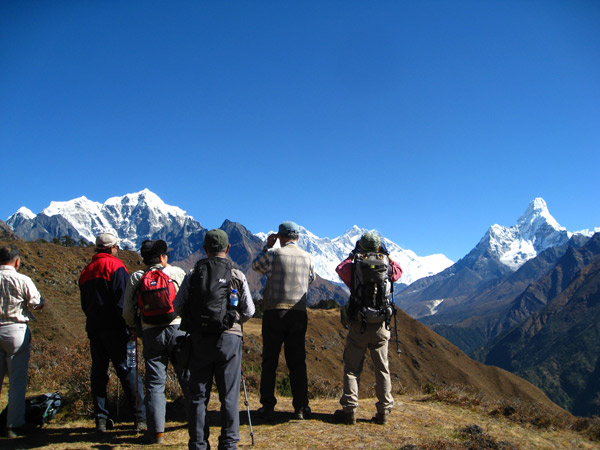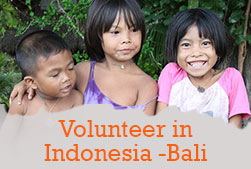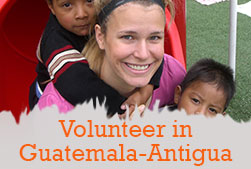Volunteer programs in this country are currently unavailable.
Volunteer in Nepal Himalaya!
Are you seeking a life-changing experience you'll remember forever? Would you like to volunteer abroad in Nepal and see an exotic part of the world while using your skills and compassion to change lives? Experience personal growth and adventure when you volunteer in the Himalaya region of Nepal.
Home to eight of the world's highest mountain peaks, the Himalaya region of north-eastern Nepal is a top travel destination. Experience the unique culture and rugged beauty of mountain valleys. Be astounded by snowy mountain peaks, green hillsides filled with a riot of colorful flowers, isolated villages, the local Sherpa people and their communities, and mountain-top monasteries.
Nepal grapples with a legacy of poverty resulting from decades of civil war and political instability. Devastated by frequent natural disasters, including the disastrous 2015 earthquake, the country suffers from poor infrastructure and access to basic services. The Himalaya region is home to the Sherpa, who for centuries depended on agriculture and trade with Tibet and the Nepal lowlands to survive. Tourism has helped, but those off the tourist trail still struggle, especially children.
Today, the Himalaya region of Nepal needs volunteers more than ever.
You can help by joining a volunteer program in the Himalaya region of Nepal. Teach English in local rural schools or to Buddhist monks, use your medical experience to support health care improvement, or work with families.
The rich cultural immersion will change you personally as you volunteer to help the Sherpa people of Nepal and become part of the solution to improve their lives.
Request information about volunteering in Nepal Himalaya and find a program that speaks to you!
Volunteer in Nepal Himalaya Programs
Global Crossroad offers variety of fascinating volunteering opportunities in Nepal! Click on the links below and check them all out to find the one that fits you.
| Volunteer Programs | Locations | Starting Prices |
|---|---|---|
| Teaching English to Buddhist Monks | Everest Region | Starts at $350 |
| Teaching English in local rural school | Everest Region | $350 |
| Hands on Medical Volunteer Abroad (2 Weeks) | $550 |
Special Programs (Volunteer + Travel, Group)
Dates and Prices
All projects start every 1st and 3rd Monday of each month. However, if there is travel constrains, you can start any project on any day.
Global Crossroad is committed to offering quality volunteer abroad programs at a very affordable price. We strive to keep our costs low so that our volunteers benefit from the lowered program prices. The humanitarian side of the business is our passion.
Global Crossroad's application/registration fee: US $299. The application fee covers our cost of advertising, program promotion, and office expenses (rent, utilities, and staff salaries in USA office).
In addition to the application fee, volunteers are required to pay weekly program fee. You pay your weekly fee directly to your host families and projects. This way, the fees you pay will benefit those who deserve it (not for company profit).
-
- 1 Week
- $350
-
- 2 Weeks
- $500
-
- 3 Weeks
- $650
-
- 4 Weeks
- $800
-
- 5 Weeks
- $950
-
- 6 Weeks
- $1100
-
- 7 Weeks
- $1250
-
- 8 Weeks
- $1400
-
- 9 Weeks
- $1550
-
- 10 Weeks
- $1700
-
- 11 Weeks
- $1850
-
- 12 Weeks
- $2000
- Airport pickup, drop and first accomodation $50
- Fly to Himalaya (Lukla) $330 (depends on season)
- Mandatory comprehensive travel insurance $3.49 a day »
- Language and Culture Program fee $250
Program fees cover:
- Accommodation (volunteers house or host family)
- Food (local food 3 times a day)
- In-country support
- Personalized project
- Pre-departure information
- Certificate of completion
- Fundraising ideas and letters
- Discount for returning volunteers
Program fees exclude:
- Visas
- Airfare
- Personal expenses on soft drinks and foods
- Daily transportation
- Airport return transfer
Language and cultural immersion program includes:
One-week language and culture training, food and accommodations with host family (Breakfast, lunch & dinner), training materials (books, papers, etc) and Comprehensive Travel Insurance.
Additional costs for volunteers:
International flights, local flight to Lukla, visa application/extension, daily personal expenses on beverages/entertainment, laundry, telephone, immunizations
The Everest region- A spectacular scenic region

The Everest region or known locally as Khumbu region, is the most popular trekking region in Nepal. You will find Mount Everest, the world's highest mountain, in this region. There are also many high Himalayans peaks of over 6 thousand meters or over dotting the landscape. The region starts from the altitude of 2600 meters and the nearest motorable road is 7 days away. Volunteers will fly to Lukla, which is about 20 minutes by flight from Kathmandu, the capital of Nepal. From Lukla, volunteers will make their way on foot to the project site.
The Everest is home to Sherpas, who have lived for centuries attending cattle, farming vegetables or trading with Tibet and the low lands of Nepal. Today, with the arrival of tourists, Sherpas have seen their lives transformed. Many of them now enjoy a steady stream of good income working as porters, guides, climbers and many have opened lodges, hotels and tea houses. But for those Sherpas who aren't involved in tourism industry or whose houses aren't in the tourist trail, including other ethnic groups who have migrated to the region, life is still a hard toil with very little hope for a better future. Their children, their only hope for a better future, attend schools that aren't well funded and many continue to have no motivation to continue their studies.
About Sherpa

The Sherpas are an ethnic group of Nepal that originated in Tibet. They live in the high valleys around the base of Mount Everest in northeastern Nepal. Their villages in region range from 2600 meters to as high as 5000 meters. They have to brace severe winter from November to February.
Much of Sherpa culture and language bears a close resemblance to the people of Tibet. Though most Sherpas speak Nepalese, they have their own language which is a Tibetan dialect. The Sherpas also use Tibetan script for writing. The Sherpas are all Buddhist, but besides the Buddha, they also believe in numerous other spirits that inhabit the mountains, caves and forests. Many mountains, like the Khumbila, which overlooks the Sherpa villages of Namche Bazaar and Khumjung, are worshipped by the Sherpas and considered guardian deity of the region. Because of this, the Sherpas do not kill any animals in the region but many do not consume meat. A monastery (known locally as Gompa) plays a very important role in the religious life of the Sherpas. The monasteries are usually located just outside the village and during religious festivals, all the Sherpas gather in the monastery to participate in the festival. The monks recite prayers and give blessings to the local people.
Until recently, most of the Sherpas depended on agriculture and trade to sustain themselves. When Khumbu region was discovered and promoted as a tourist destination, the Sherpas started working as porters, guides and climbers and this saw their lifestyle transformed. Many families also prospered by opening hotels, lodges and restaurants along the trekking routes. Sir Edmund Hillary, the first to summit Everest, used his fame to raise funds to open an airport in Lukla, connecting Khumbu region with the rest of the world. He also opened schools and hospitals.
Many Sherpas have benefited from this. Today, people from other regions and other ethnic groups are migrating to the Khumbu region to take advantage of this prosperity. But they find themselves paying high rent, and are dependent on seasonal hard labor. They also find it hard to send their children to well run schools. It is these people who need your help the most.
Frequently asked questions - Nepal-Himalayan Region
Application Process/ Visa
- When should I apply for the volunteer/internship programs in Nepal?
- What happens once I submit my documents and application to Global Crossroad?
- How long does it take to process my application?
- What documents do I need to submit with my application?
- Are there any necessary requirements to participate in the Nepal-based volunteer programs?
Placement Information
Arrival and Departure Information
- Who will arrange my flight to Nepal?
- Which airport should I book my flight into?
- When should I arrive in Nepal?
- Will someone pick me from the airport? If so, how do I know about the person?
- What should I do if my flight is delayed?
- How can I get to the hotel from the airport if I did not see Global Crossroad's local representative in the airport?
- What do I need prior to departure from my home country?
- If I want to arrive earlier than when the program begins, where do I stay and who will organize the accommodations?
- When should I depart from Nepal?
- Which airport will I fly out of?
- Who will drop me off at the airport?
- Can I store my luggage if I arrive earlier than my program starts?
Living Accommodations Information
- Who will arrange my accommodations and what are they?
- Are singles rooms available?
- If I arrive with my friend, or girlfriend/boyfriend, can we stay together?
- Will there be other foreign volunteers/interns at my placement?
- What are the bathroom facilities?
- What are the laundry arrangements?
- Can I use appliances if I bring them from my home country?
- What are the local cuisines? Who manages food?
- Can you supply special diets?
- Is the running tap water safe for drink?
Health and Safety
- How safe is Nepal?
- More about Travel Safety to Nepal
- What are the principle health risks?
- Recommended Vaccinations and Preventive Medications
- What health precautions should I be aware of and tend to?
- Do I need health insurance?
- Who do I contact in case of a health-related emergency?
- Is the food safe if I buy it from a street vendor?
Money
Communication
- How do I make contact with Global Crossroad's local coordinator?
- How do I contact my family once I arrive in Nepal?
- Are internet services easily available?
- How can my family members contact me?
- Can I bring my telephone from my home country?
- Can I purchase phone service once I arrive in Nepal and how much will it cost?
Culture and Custom
Coming Soon
Coming Soon
Coming Soon
Coming Soon
Coming Soon




